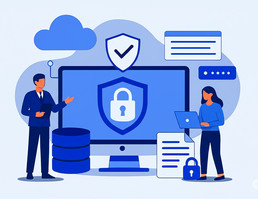Choosing the right employee monitoring tool can be tricky. On paper, many solutions look similar, but in real-world use, differences matter. In this WorkTime vs AnySecura comparison, we break down how each platform handles time tracking, productivity monitoring, and policy enforcement. WorkTime keeps things simple, focusing on basic KPIs and app or website usage, making it easy to see who worked when. AnySecura goes deeper, tracking behaviors, file operations, emails, and context, giving managers the evidence they need to understand why productivity rises or drops. This guide walks through features, dashboards, and controls to help you decide which tool fits your team best.
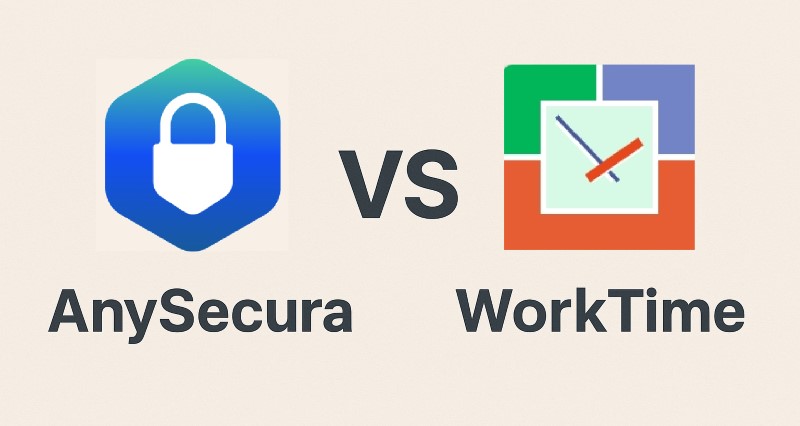
1. Employee Monitoring: What can you actually see?
To understand how these tools actually feel in day-to-day use, it helps to start with what shows up on screen in real time. Below I outline each product's monitoring dimensions
| Dimension | WorkTime | AnySecura | Why it matters |
|---|---|---|---|
| Attendance data | System Startup/Shutdown, sleep/wake, lock/unlock, remote-desktop connect/disconnect, and active/idle state | System Startup/Shutdown, User Login/Logout, sleep/wake, remote-desktop connect/disconnect, activity start/stop | Shows when people are working and helps check attendance |
| Apps usage | Time by app (efficient/inefficient/undefined) | Time by app (custom classification) ➕ blocked/flagged attempt times |
Helps see which apps take up time and spot distractions |
| Web browsing | Time by site (efficient/inefficient/undefined) | Time by site (custom classification) ➕ blocked/flagged attempt times ➕ Keyword Search |
Makes internet use clear and easy to review |
| Documents | Time by document (efficient/inefficient/undefined) | ✅Full file ops: create/open/modify/copy/move/delete/restore/rename | Links effort to outputs; backups reduce rework and protect progress |
| Peripherals | Mic & camera usage duration | ✅All peripherals, covering storage, communication, USB, network, and other devices, with usage control. | Shows how devices are used and highlights possible risks |
| Network traffic | ❌ | Protocol/port/address breakdowns | Helps explain slow networks and non-work activity |
| Print event | ❌ | Time, endpoint, user, app, pages, printer type/name; query by time/file/computer | Captures paper pathways of work; useful for sensitive processes |
| Instant messaging | ❌ | Conversation time, participants, content for major IM tools | High-signal distraction (or work) channel-use with policy |
| Email activity | ❌ | Sender/recipient, body, attachments (standard/Exchange/webmail/Lotus) | Helps check workload and possible data leaks |
| Screen monitoring | ❌ | Screenshots / live view; export to video for playback | Shows real work on screen; requires governance and consent |
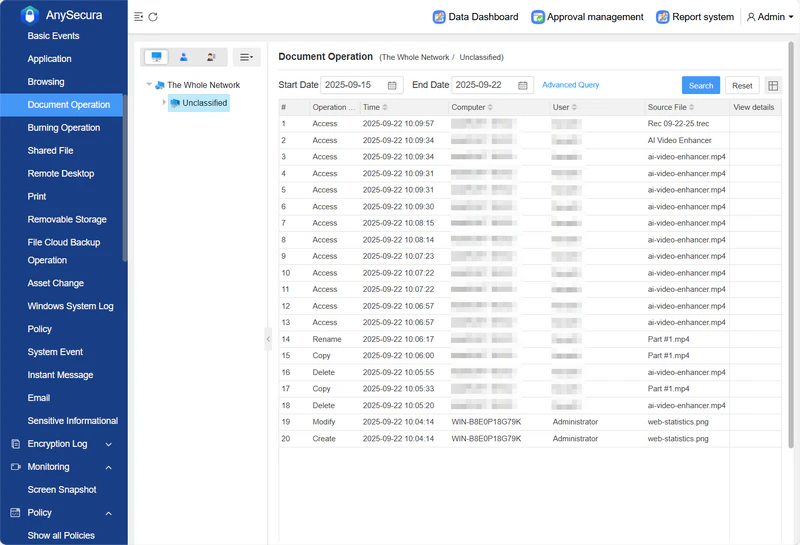
Monitoring depth
In employee data that are tracked you get to see the different patterns of these two tools: WorkTime focuses on time spent, while AnySecura covers the full trail of activity.
WorkTime monitors only two behaviors: open and close, through these two behaviors it calculates durations of every kind of activity. In other words, it records time and uses it as evidence of employee activities. And we all know that's not persuasive.
For apps and web, AnySecura not only records time but also counts blocked or flagged attempts that you set as not allowed in the policy management module (which WorkTime doesn't include). The detail goes beyond app or website names—you also get to see the keywords searched. For documents, WorkTime only times usage, while AnySecura tracks the entire file lifecycle—create, open, modify, copy, move, delete, restore, rename. All these details give you more evidence and signals to explain drops in productivity without guesswork. The more you see, the more accurate your understanding.
Monitoring breadth
WorkTime monitors four basic activity types: app usage, website usage, document usage, and mic/camera activity.
AnySecura, on the other hand, goes much further to capture what truly slows people down during daily work. For example:
- if someone is downloading a large movie that clogs office bandwidth, network monitoring reveals which PCs are generating heavy personal traffic (like to personal cloud services) so you can cut it off.
- For IM, it shows when and with whom employees chat most—and whether those chats are focused on the project or drifting into off-topic talk.
- For email, AnySecura doesn't stop at tracking senders and recipients; it also analyzes subject lines, body text, and attachments. That way, managers can quickly see if long email threads are eating up work hours or if team discussions are veering away from deliverables.
- And when needed, screen monitoring captures short snapshots of active apps, giving managers concrete examples for coaching instead of speculation.
If your priority is spotting and cutting distractions, AnySecura is easier to use day to day. It adds the context—attempts, file actions, traffic patterns, and message activity—that helps managers make decisions faster and keep people focused.
2. Behavior Analytics: How do they help you understand employee activity?
This section explains how each product turns captured data into actionable insights you can read, compare, and act on. In the following subsections, we’ll break down the key areas of comparison: how time is handled, classification and grouping, data analysis and reporting, and the alert system. Each part highlights the differences between the two tools and what to pay attention to when monitoring employee productivity.
| dimensions | WorkTime | AnySecura |
|---|---|---|
| Time frames |
|
|
| Aggregation | Company → department/office → employee/computer. | User/computer → groups → department (flexible rollups). |
| Classification |
|
|
| What's measured |
|
|
How time is handled

WorkTime can only report by day, by week, by month or a selected period.
AnySecura goes further: it lets you set custom time windows, like work hours, break times, weekends, or even one-time events. For example, you may want to see productivity only during official “work hours”, or exclude a department outing that happened on a weekday. In WorkTime, these special cases show up as noise and create “dirty data”, which can make results less accurate. With AnySecura, the system filters those situations automatically, so you don’t have to clean the numbers by hand. This makes reports fairer and more accurate, especially for teams with shifts or flexible working hours.
Classification and grouping
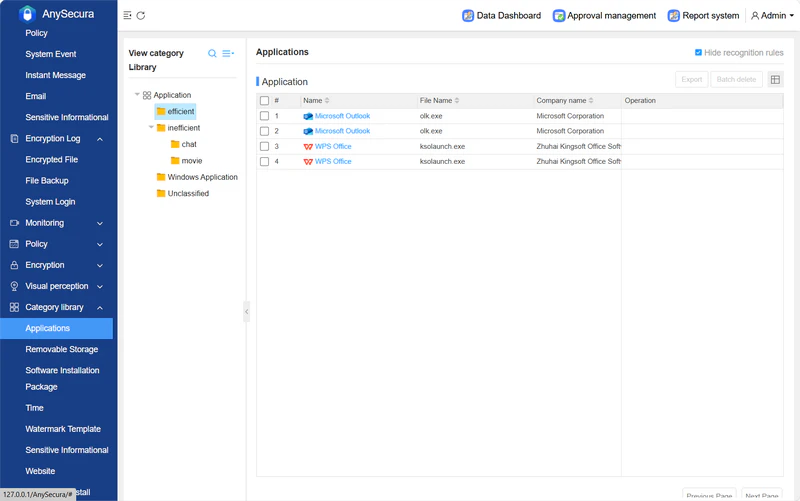
WorkTime has a tagging function, which allows you to label apps and websites as productive, unproductive, or undefined. This helps managers quickly categorize and review employee activity, making it easier to spot which tools contribute to work and which might be distractions. However, the tags need to be added manually, and the system is limited to apps and websites, so it may not capture the full picture of employee behavior.
AnySecura offers a much wider system: you can classify apps, websites, mobile storage, time types, network addresses, ports, and even emails. You can also build or import recognition rules, use wildcards, or import a full website library that you prepare in advance. This means you spend less time on manual work, avoid blind spots, and get a clearer and more convenient view of how employees use different tools.
Data Analysis
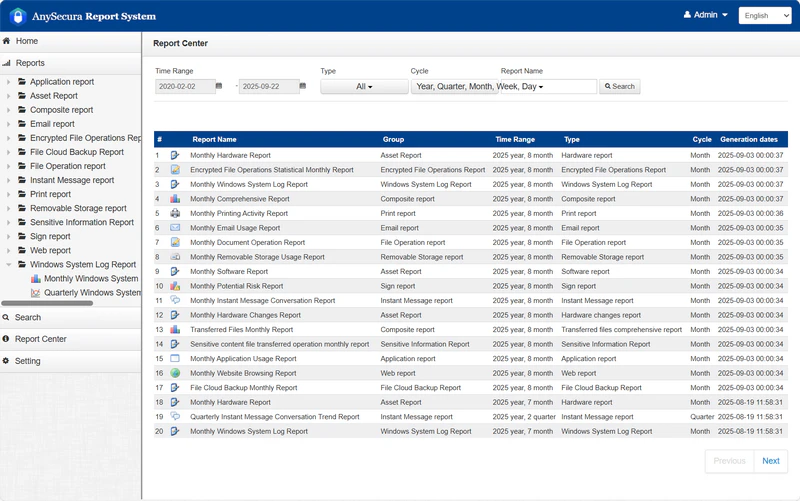
WorkTime gives you pre-set reports that appear on a dashboard. These cover attendance and the time employees spend on productive or unproductive apps, documents, and websites. If the report you want happens to be included, then WorkTime is enough. But if you need something custom, you will have to export the raw data and either analyze it in another program or hire someone to do it.
AnySecura provides a full reporting system. It lets you combine different conditions, view results with charts and tables, and track how things change over time. It even supports custom dashboards, so you can decide exactly what data to see. Reports can also be scheduled—daily, weekly, or monthly—and once set up, they run automatically. You can pause or delete them at any time. This means managers can always access the exact insights they need.
👉 Want to know more about how the reporting system works and what you can do with it? Reporting System - Statistical Settings.
Alert System
WorkTime’s alerts system mainly focus on metrics such as “unproductive,” “idle,” or “late”,
Similar to WorkTime’s alert system, AnySecura also supports viewing indicator reports. AnySecura’s alert logic is based on indicators of inappropriate behavior defined by administrators. Each indicator can be assigned a severity level—Severe, Important, or General. For example, in print operations, an inactivity ratio of 40% can be classified as Severe, 20% as Important, and 5% as General. This approach makes the system more flexible.
3. Policy Enforcement: How much control do you have?
This is WorkTime's biggest gap: it can monitor and record, but it can't enforce. At its core it's a productivity and HR analytics tool; without strong day-to-day management, it won't meaningfully raise team output. By contrast, AnySecura lets you define policies that directly control employee endpoints, so you can enforce a unified set of rules. With it, you can achieve scenarios like the following:
- Block games, video sites, and personal social apps during work hours; allow them on breaks.
- Show an on-screen warning when someone tries a blocked app/site; log the attempt.
- Lock the computer after repeated violations; notify the admin console right away.
- Allow only company Wi-Fi; block unknown networks and hotspots.
- Schedule rules by time (work / break / weekend / custom shifts) and target them to users, groups, or devices.
- ......
All of the wins above come from simple, reusable policies. You set them once and apply them where they matter.
🛡️ What kinds of policies does AnySecura offer?
| Policy area | What you can do | Usecase |
|---|---|---|
| Time windows & priority | Apply rules to work hours, breaks, weekends, or split shifts. Specific rules can override general ones. | Call center 9:00–18:00: 9:00–12:00 & 13:00–18:00 short-video sites are blocked; 12:00–13:00 (lunch) they're allowed. |
| Applications | Block by process, category, path, or service. | Developers: VS Code & Terminal allowed. At 10:15 a game launcher opens → message “Games are blocked during work hours”; attempt is logged and the user returns to the IDE. |
| Web browsing | Deny non-work domains or use an allow-list with wildcards. | Sales PCs: Only CRM, email, maps, pricing pages allowed. At 15:30 a job board is blocked; a short message explains why and the console records the domain and time. |
| Devices & peripherals | Control USB, cameras, audio, burners, and Wi-Fi. | Finance: Only company USB drives. At 11:05 a personal USB mounts read-only; cannot copy files out. Speakers muted 9–18 to stop music streaming. |
| Documents & printing | Set rights; auto-backup before risky actions; control printing by app/printer. | Shared Excel: A wrong formula is saved at 16:20 → auto-backup keeps the old version; user clicks “Restore previous.” Unapproved printing shows “Use Secure Print” and does not start. |
| Email, IM, uploads | Limit by app, size, recipient, site, IP, or port; optionally keep evidence. | Office hours 9–18: Webmail blocked; Outlook allowed with company signature. IM files > 5 MB are stopped and logged. Personal-cloud uploads limited to 0 MB/s. |
| Network & bandwidth | Throttle or zero-rate by IP/protocol/port. | Design PCs: Torrent ports blocked; personal-cloud traffic set to 0 KB/s. Figma/CDN traffic untouched; morning reviews load quickly. |
4. Dashboards Visualization: Do the visuals answer your questions?
If you are someone who values appearance and visual design, this is the one area where WorkTime clearly takes the lead. WorkTime offers a variety of beautiful dashboard styles that are pleasing to the eye and make data feel more engaging. Its visualization features are more polished and colorful compared to AnySecura.
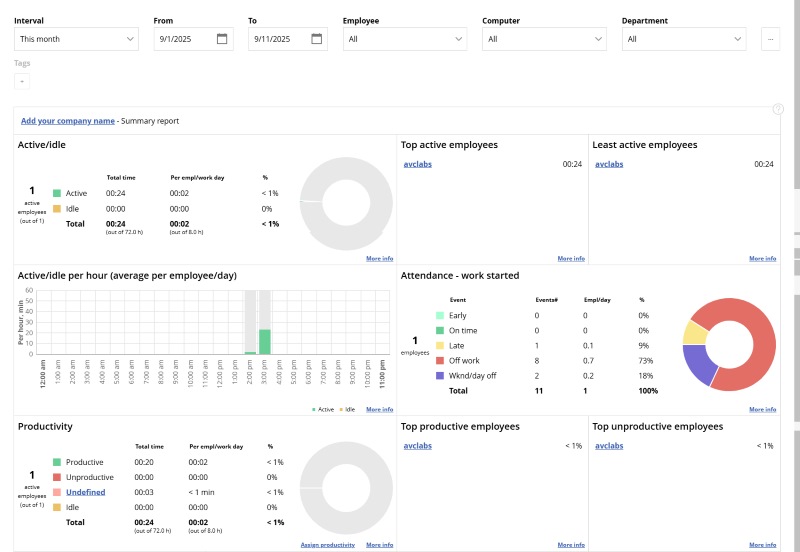
Chart Displays
- Line Charts: Show trends over time, including active hours, productivity levels, attendance rates, and the number of alerts triggered.
- Timeline Bars: Break down each day into time blocks, highlighting “effective work hours” in green. This makes it easy to see work versus non-work periods at a glance.
- Pie Charts / Proportion Charts: Display the ratio of productive, unproductive, and undefined hours.
Color Highlights
- Attendance, activity, and efficiency are marked with different colors to show whether targets were met (green = on target, red/orange = below target).
- Key indicators like active time or efficiency ratio are also color-coded, making potential problems quick to spot.
Leaderboards
- Rankings for efficiency, active time, and attendance across departments or employees.
- Public recognition of “Best Department” or “Best Employee,” with results available on a weekly or monthly basis.
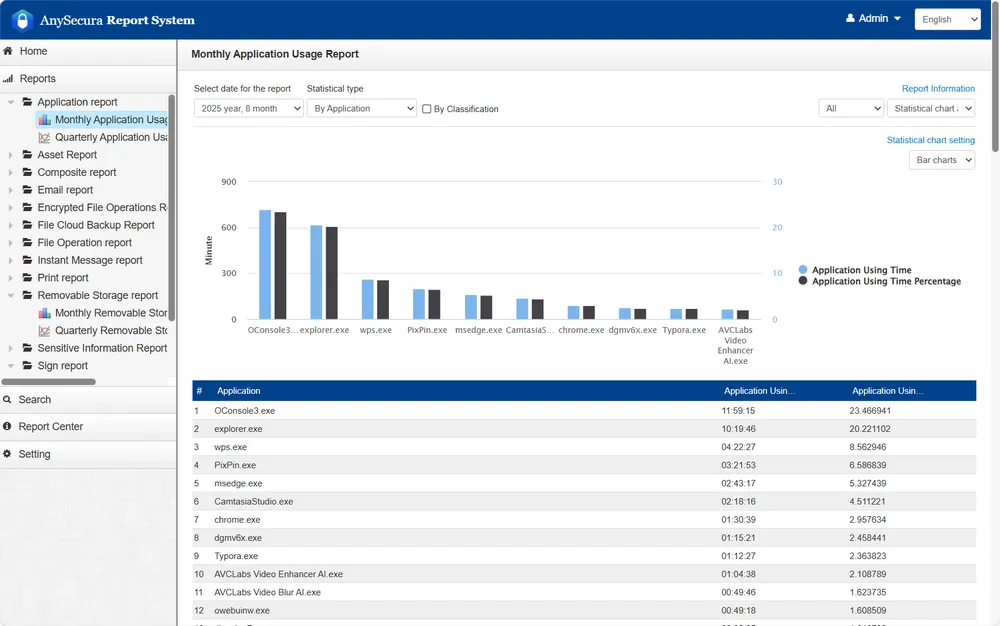
AnySecura, by contrast, takes a more straightforward approach. It mainly uses bar charts to show data, line charts to show trends, and pie charts to show proportions. Unlike WorkTime, it does not include timeline bars. Also, because AnySecura does not measure productivity based on whether employees meet a fixed number of hours or ratios, it does not use color coding to mark “pass” or “fail.” Instead, it focuses on giving managers more evidence and context to understand performance beyond just time-based targets.
FAQs about WorkTime and AnySecura
Q1: Is WorkTime easier to set up than AnySecura?
Yes. WorkTime is lightweight and can be up and running quickly. AnySecura takes a bit more time to configure because of its broader feature set, but once set, it requires less manual cleanup later.
Q2: Do both tools respect employee privacy?
Both tools can be configured to balance monitoring with privacy. WorkTime mostly tracks time and apps, which is lighter. AnySecura offers deeper visibility (emails, IMs, file actions), so companies usually define clear policies and get employee consent before using advanced features.
Q3: Which one is better for large teams with different shifts?
AnySecura is better suited for teams with flexible schedules or multiple shifts. It lets you define custom time windows, categories, and policies that WorkTime can’t handle as easily.
Q4: If I only care about dashboards and visuals, which tool should I pick?
WorkTime. Its dashboards are more polished and colorful, with timelines, leaderboards, and clear highlights. AnySecura’s visuals are more functional than pretty.
Conclusion
At the end of the day, the right choice depends on what you need. If you just want quick numbers to see who worked when, WorkTime does the job and looks nice while doing it. But if your goal is to dig into the reasons behind productivity shifts, control policies in real time, and get flexible reports you can trust, AnySecura is the stronger option. Both tools have their place—it’s just a matter of whether you prefer simplicity or depth.
🚀 Take the next step. Download and see how AnySecura transforms your enterprise security and productivity management.


